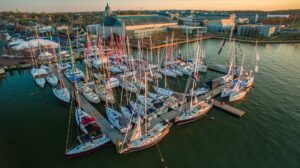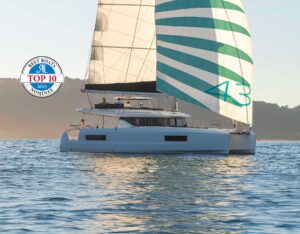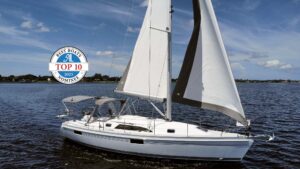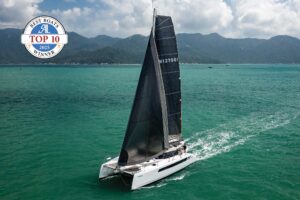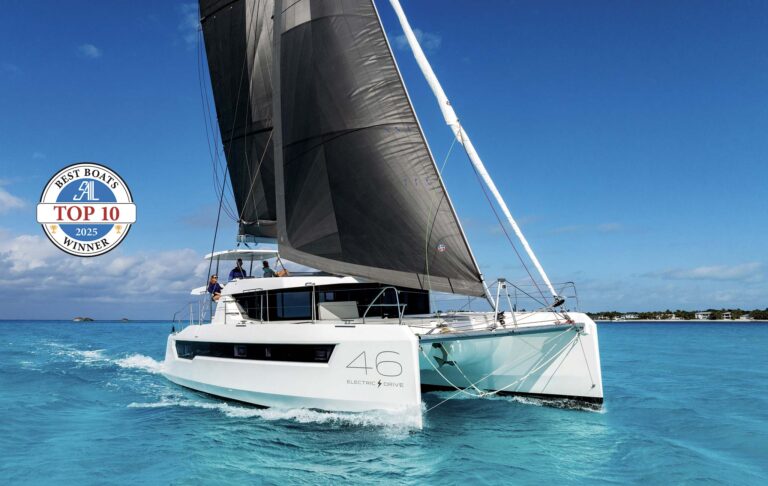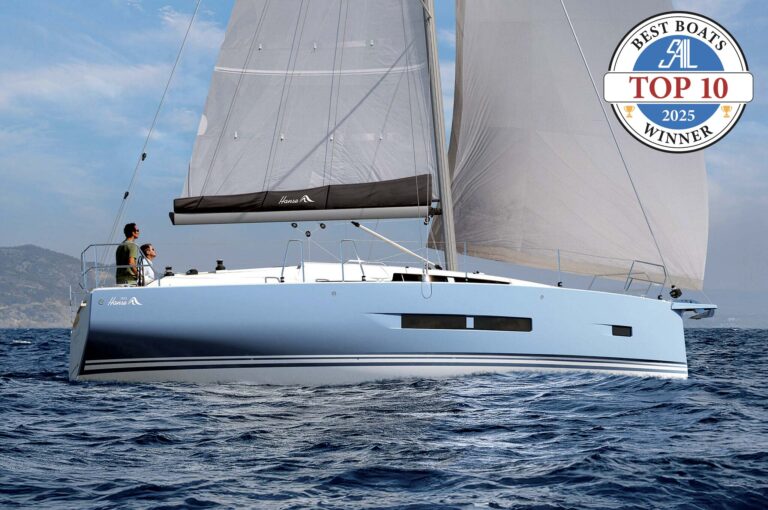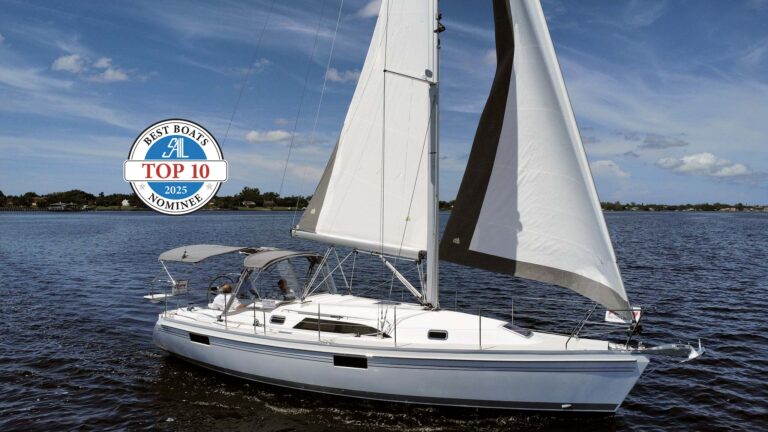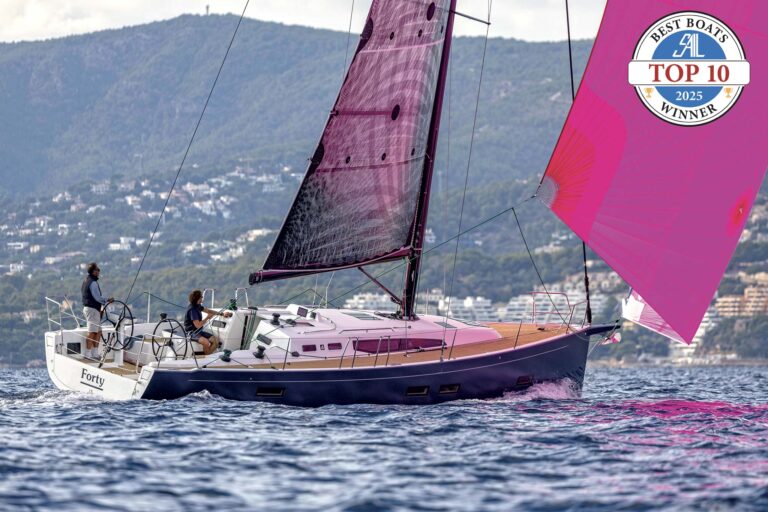
I was aboard Joule, the latest version of the Windelo 50, twice before I ever sailed her—the first time at the Cannes Yachting Festival in France last fall, and the second at the Miami International Boat Show in February. She had sailed transatlantic with the Atlantic Rally for Cruisers, reportedly reaching up to 15 knots of boatspeed, and by the time she arrived in Miami, owners Jay Bibb and Barry Vial were excited to finally have their new home on this side of the Atlantic. When I met them to go sailing, they had moved aboard and were preparing to cruise the East Coast and Bahamas.
Our test day was spicy but comfortable, especially for this bluewater cat with a layout and design philosophy meant to bolster confidence in offshore passagemakers. With 15 knots of true breeze and a 2-foot chop, we made good 9 knots at 60 degrees AWA and still held onto 6.2 knots when we pinched up with the self-tacking jib to 40 degrees AWA. With the code zero, we did 10 knots at 110 degrees AWA when the wind puffed up to 17 knots.
The daggerboards were about 25% down, adding a bit of grip upwind. These boards, which helped the boat point higher, and her high, 35-inch bridge clearance are among the features that separate the Windelo from more basic production models. Her construction, propulsion, and layout also make her a cat of a different stripe.
The Windelo 50 was first launched in 2021 by a newcomer French yard based in Canet-en-Rousillon. Since then, they’ve leaned heavily on sustainability as their differentiator by adding diesel/electric hybrid power and innovating in their building materials with this latest version, designed by naval architects Christophe Barreau and Frédéric Neuman.
To understand the impact of these elements, it helps to learn how the carbon footprint, or environmental impact, of a boat is divided. According to a recent report by the International Council of Marine Industry Associations, 50% of the environmental stressor is from construction, 40% is from use, and 10% from end-of-life disposal.

Windelo focused on the first two elements with special construction methods using volcanic basalt fiber, rather than traditional fiberglass, in their woven rovings. For a core material, Windelo turned to recycled PET (polyethylene terephthalate, commonly used to make plastic bottles), which is presented as half of the carbon footprint of virgin PVC foam. Divided by structural need, 45% of their catamarans is PVC and 55% is recycled PET. (Using PET throughout would require higher foam density, which translates to more weight, which is not eco-friendly for the boat’s use.) They also optimized interior furniture, creating a lighter composite with two-layer FSC plywood placed on either side of PET foam.
To lessen the boat’s environmental impact during use, they outfitted the newest version with twin, shaft-driven 20 kW Bellmarine 20 kW electric motors with an 18kW diesel generator range extender that the builder says can recharge the batteries from empty to full in 1.5 hours. With a 1,120 Ah 48 V lithium battery bank (53.8 kWh) and nearly 6,000 watts of walk-on solar panels on the foredeck and hardtop, the boat can reportedly motor two to four hours at 5-6 knots on electric power only. That won’t get you across an ocean, but that’s what the sails are for.
The architects also redesigned the deck and cabintop, changing the profile and lengthening the hardtop. This improved aesthetics and added 3.5 additional feet for solar panels, helping the boat generate 30% more energy. Power gathering through hydrogeneration is also possible via the propellers, but you must be sailing at least 9 knots for any measurable regen to happen.

Besides build materials and propulsion, Windelo’s non-traditional layout sets her apart from her competition. Rather than the usual helms aft in a large cockpit, Windelo has moved the helms forward in a fully enclosed space with all sail controls. While other multihull designs have employed a forward cockpit before, none have taken it to the fully enclosed concept that Windelo has.
Two steering wheels are about 6 feet apart with three winches and line organizers in the middle. The throttles for the electric motors and the Garmin MFD are to starboard. The seats on both sides have been widened and skylights over both sides provide good views of the mainsail. Access to the foredeck and, in turn, the mast is immediate through a centerline companionway.
During our test sail, at first I felt like I was driving from inside a living room, but as we sailed, the concept grew on me, and I could see its appeal for shorthanded sailing in complete comfort and safety. The forward cockpit can be closed up so that it’s fully protected from the elements, and an additional glass door separates it from the salon, where the nav station to port and galley to starboard are immediately at hand. The combined enclosed space builds confidence in offshore sailors because you barely have to go on deck, and it almost feels like the one who’s sailing and the one who’s cooking or navigating are in the same space, which can be comforting.
The view forward from the helms is excellent, but a drawback is the visibility aft. The bulkhead between the galley and the starboard helm is solid and creates a complete block of whatever is going on behind you, which takes getting used to. Backing into a slip will take practice or a backup camera, or both.

The windlass is also incorporated into the center console where steps lead up to the foredeck. I noticed the anchor chain hanging below the longeron instead of riding in a well above. I’d never seen chain placement like that and had to wonder if it would bang in a heavy seaway.
In its revamp, Windelo also changed the salon layout. The galley can be placed aft as it was originally or moved into the forward starboard corner as it was on Joule. I’m more of a fan of the aft orientation for three reasons. First, the views are better, since you’re not right up against that solid bulkhead. Second, the galley aft improves traffic flow to the starboard cabins because that access is ahead and out of the way of the galley, rather than cutting right through it. And finally, with the galley forward, twin drawer fridges hang precipitously over the stairwell down to the cabins, and if you should lose your footing while grabbing a stick of butter, you could tumble a long way down.
Windelo also changed the way you enter the salon from the aft terrace. Initially, access was via a door that lifted to the cabintop like a garage, similar to Bali catamarans. Windelo has since moved away from this, opting for traditional glass sliders. However, that still leaves all the living space technically inside the boat. You can open doors and massive windows for cross ventilation, but there’s no aft cockpit as such. In fact, other than the long trampolines, there’s little actual space to lounge outside. It’s kind of the perfect boat for people who like shelter from the sun, which isn’t a bad thing.
Speaking of the aft terrace, Windelo integrated a section into the mold that acts like a transom providing security when under way but that extends the aft deck or nacelle when lowered at rest. This section also holds the dinghy davits, so once you launch the dink, you have room to add a couple of deck chairs and enjoy a bit of the outdoors.
Accommodations include the owner’s suite in the port hull complete with a large head forward, a desk in the middle, and an athwartship bed aft with room at the foot to climb in and out so nobody has to vault over their partner in the middle of the night. The starboard hull has two cabins, a narrow one forward and a double aft.
Windelo offers the W50 in three packages: Adventure, Yachting, and Sport. Prices rise with the outfitting level, with the Yachting version, like Joule, starting at $1.2 million. Add a carbon mast and boom for another $125,000, and you have the beginnings of the racy Sport version. The customization options are many, so you can make the boat your own to a degree.
Windelo’s production plan is to build 10 boats per year, and with that capacity, the company is booking units out into 2027. Their unique layout philosophy makes Windelo boats polarizing, but with a full build schedule that stretches out three years, it seems there are plenty of devotees of the forward cockpit and enclosed concept. Buyers such as Barry and Jay like the comfort and confidence it builds when venturing offshore, and burning less diesel when motoring between islands of the Bahamas has its own appeal.

LOA 50’1”
Beam 26’0”
Draft 3’5”
Air draft 76’
Displacement 26,692 lbs (34,000 loaded)
Sail Area 1,453 sq ft upwind
Power 2x 20 kW Bellmarine electric engines
Designer Christophe Barreau, Frédéric Neuman
Builder windelo-catamaran.com
Base price (Yachting version) $1.2 million
Meet the Other 2025 Top 10 Best Boats Nominees

August/September 2024


